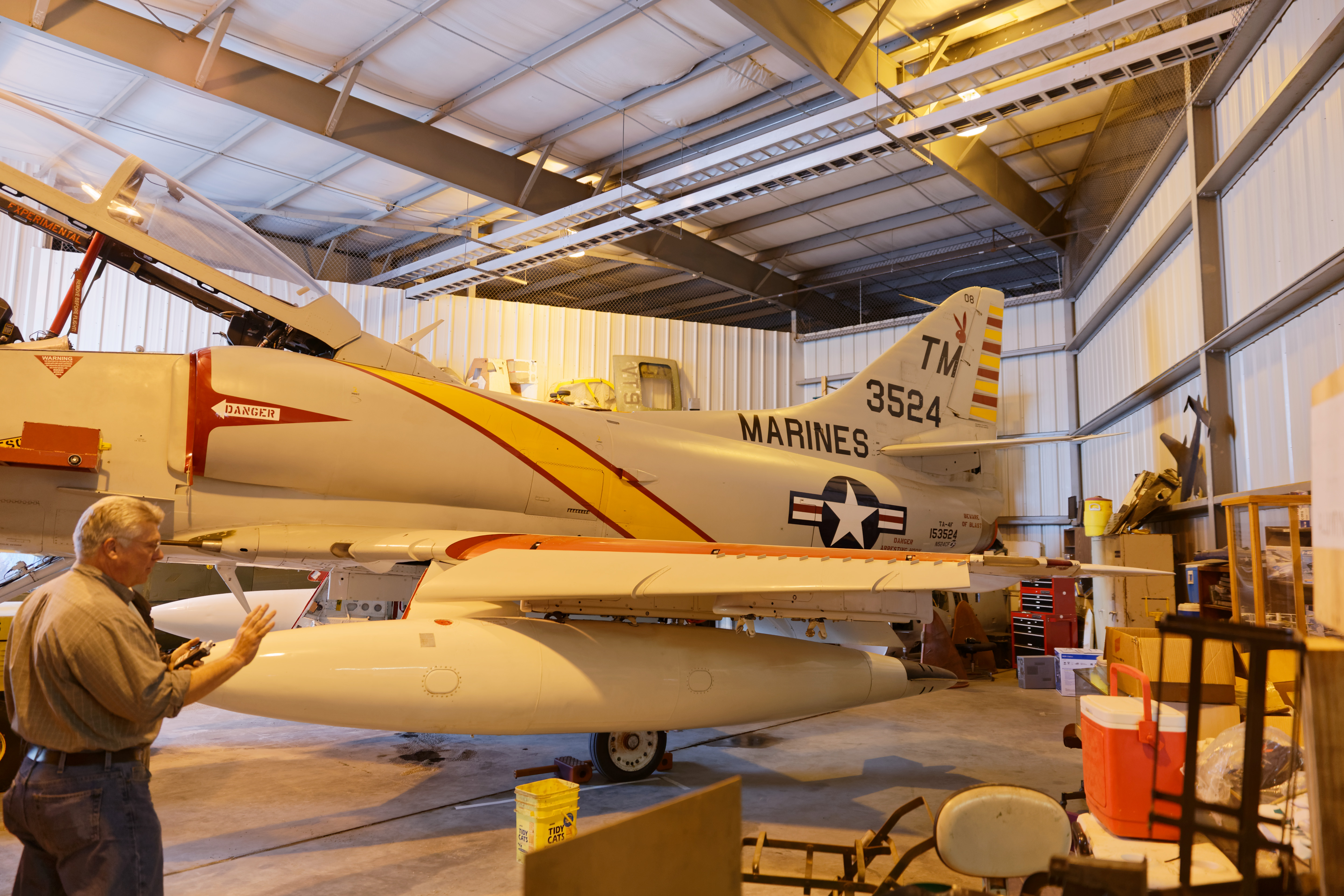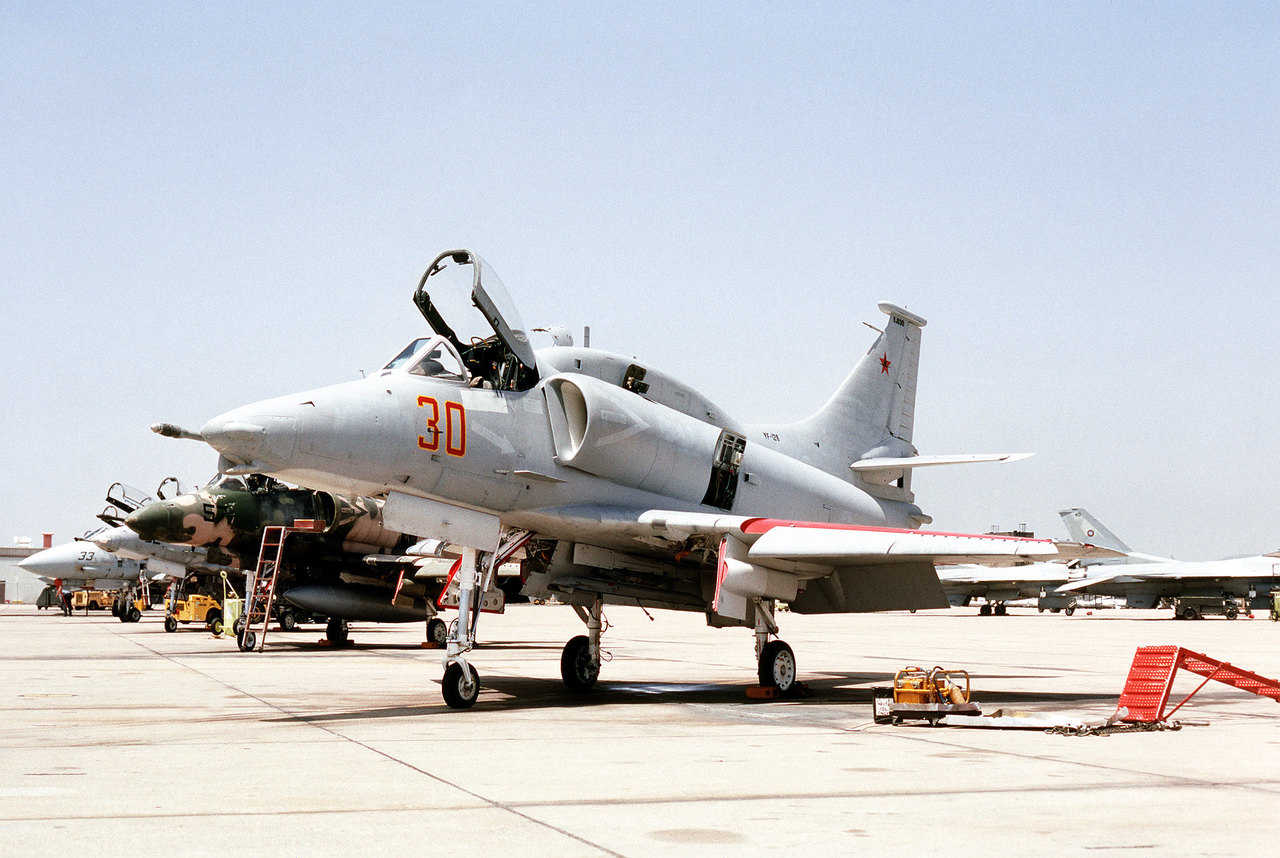A4 Jet Fighter - The McDonnell Douglas A-4G Skyhawk is a variant of the Douglas A-4 Skyhawk fighter developed for the Royal Australian Navy (RAN). This model is based on an A-4F variant of the Skyhawk, with slightly different avionics and the ability to operate the AIM-9 Sidewinder air-to-air missile. The RAN received t A-4Gs in 1967 and another in 1971, and operated this model from 1967 to 1984.
While in service in Australia, the A-4G was part of the Royal Navy's Carrier Air Group in Melbourne, primarily for fleet air defense. They take part in exercises in the Pacific Rim and also support the training of Royal Australian Navy warships and other branches of the Australian military. The Skyhawks saw no combat, and plans to deploy some of their pilots in the Vietnam War were scrapped. The T A-4G was destroyed while in service with the Navy due to equipment failure and non-combat accidents, resulting in the deaths of two pilots.
A4 Jet Fighter

After Melbourne was decommissioned in 1982, the RAN no longer needed most of its fixed-wing aircraft, and two years later the remaining A-4G aircraft were sold to the Royal New Zealand Air Force (RNZAF) for training purposes. Between 1986 and 1991, the aircraft were upgraded and renamed A-4K. Two ex-A-4Gs crashed in 2001, killing one pilot. RNZAF's Skyhawk fighters were retired in 2001. Eight A-4Ks, including six ex-A-4Gs, were sold to Drak International in 2012 to support US military training exercises.
A 4e Skyhawk
In the late 1950s, the Australian government and the Royal Australian Navy (RAN) were considering options to replace the aircraft carrier HMAS Melbourne and its air group. Although Melbourne did not enter service until 1955, the de Havilland Heyward fighter jets and Fairey Gannet maritime patrol aircraft operated by the Fleet Air Force (FAA) were becoming obsolete. Melbourne was considered too small to operate more modern aircraft, so the RAN explored the option of buying a larger airline. The government felt the cost of the new aircraft carrier was too high, especially considering the cost of the Australian Army and Royal Australian Air Force (RAAF) procurement program at the time, and announced in November 1959 that the FAA would discontinue the program and began operating fixed-wing aircraft in 1963.
The government finally agreed to buy the new fixed-wing aircraft, thanks to the intervention of Secretary of the Navy John Gorton. Gorton served as a fighter pilot in World War II and developed a fascination with his work. In 1961, Gorton persuaded the cabinet to fund a program to revitalize the FAA, starting with the purchase of 27 Westland Wessex anti-submarine helicopters.
The plan was to keep HMS Melbourne as a helicopter carrier, but in mid-1963 the government allowed the Navy to continue using HMS Highworm and HMS Gannet until at least 1967.
In June 1964, Secretary of Defense Sator Shane Paltridge rejected the Navy's offer to buy Essex-class aircraft carriers from the US Navy.
The Slowly Fading Art Of Flying—and Maintaining—cold War Fighter Jets
During a visit to the US Naval Base in Subic Bay, Philippines, in July 1964, Melbourne hosted flight tests of the A-4 Skyhawk and the Grumman S-2 tracker.
The Skyhawk was a particularly light and compact attack aircraft, with wings small enough that no folding mechanism was required.
American Trackers flew from a carrier during exercises in 1957, and the Royal Canadian Navy successfully tested Skyhawks from sister ship HMCS Bonavture in Melbourne. The trials at Subic Bay were good and confirmed that Melbourne only needed minor modifications to safely operate both types of aircraft.

In late 1964, the RAN applied for government approval to rearm Melbourne and purchase a force of 18 Skyhawks and 16 trackers. Skyhawks will be used for air defense of fleets and for attacking warships and land targets. navy office
Brazilian Navy Is About To Complete A 4 Skyhawk Aircraft Upgrade
View strikes at sea as a logical mission for the FAA; the RAAF argues that the 24 Geral Dynamics F-111C planes it has ordered will function more effectively. Cabinet approved proposals to modernize the airline and acquire Trackers in November 1964, but delayed a decision on Skyhawks at that time.
After further naval lobbying and human resources work, the government finally agreed to buy the Skyhawks for £9.2 million in early 1965.
These aircraft are the first newbuild Skyhawks to be sold to any country other than the United States.
The Australian Skyhawk, designated A-4G, was a variant of the A-4F Skyhawk. The last single-seat Skyhawk developed specifically for the U.S. Navy, the A-4F first flew in 1966; 164 were eventually delivered.
Lockheed Martin A 4ar Fightinghawk
It had a more powerful engine than earlier Skyhawks and was better protected from ground fire.
In contrast, the A-4G lacks the distinctive "hump" of the avionics behind the cockpit of the A-4F (nicknamed the "Camel"). The A-4G is also better suited for air-to-air combat, and can carry the AIM-9B Sidewinder air-to-air missile.
The two-seat TA-4G trainers are equipped with the same avionics and armament as the single-seat aircraft, but cannot be operated from Melbourne as their flight characteristics do not allow them to be safely lifted from a ship for a 'bolt' landing.

Ten Skyhawks were delivered to the Royal Australian Air Force in 1967. The first A-4G test flight took place on July 19 of that year, and the first TA-4G flew two days later.
Douglas A4 Skyhawk Jet Fighter Of The Royal Australian Navy Stock Photo
On July 26, an A-4G and a TA-4G were handed over to the RAN in a ceremony at McDonnell Douglas' facility in Long Beach, California. In October of that year, Melbourne set sail for the United States to receive Skyhawks and Trackers, and the A-4 departed from Naval Air Station North Island, San Diego. The airline flew the planes back to Jervis Bay in New South Wales, where they were offloaded and transported by road to the naval air base aboard HMAS Albatros near Nowra. After completing this task, Melbourne sailed to Sydney to begin an overhaul in preparation for the new fleet.
Additional t A-4Gs were purchased in 1969. Funding for the aircraft comes from the cancellation of a plan to expand the Navy's Oberon-class submarines from six to eight. The change proved to improve the airline's efficiency and expand the FAA's strike capabilities.
Like the initial order, the purchase includes eight A-4Gs and two TA-4Gs. Skyhawks are ex-US Navy A-4Fs converted to A-4G standard before being delivered to Australia. The aircraft were taken over by HMAS Sydney in San Diego in July 1971 and delivered to Jervis Bay the following month.
Australian Skyhawks retained their USN serial number, but also received the shorter "buzz" number painted near the nose. The first batch of A-4Gs were numbered 882 to 889, and the second batch was numbered 870 to 877. The first two pairs of TA-4G are 880 and 881, the second pair is 878 and 879.
The Story Of The A 4 Scooter, The Light Attack Plane That Became The Perfect Adversary Aircraft
Operations of the RAN Skyhawk began in 1968. On 10 January of that year, 805 Squadron recommissioned HMAS Albatros to operate the aircraft in Melbourne. Skyhawk flight training began later that month, with a U.S. Navy officer and two other Australian pilots briefing six experienced pilots who had previously deployed to the U.S. to qualify as instructors.
A lack of spare parts disrupted flight activity for much of the year, and the first course ended in mid-December 1968 instead of May as originally planned. The shortage was largely due to the U.S. Navy's prioritization of resupplying its troops operating in Vietnam, rather than the needs of the Royal Australian Navy.
In November 1968, the A-4G took part in sea operations for the first time when it landed with British airline HMS Hermes during a visit to Australia.

In 1967 and 1968, the Australian government considered using pilots from 805 Squadron to fight in Vietnam. On 12 May 1967, government naval authorities recommended that six Skyhawk pilots and their ground crews, who had completed training on the new aircraft, be made available to the US Navy by next May. This decision was motivated by the desire to employ and profit from the pilots while the overhaul was completed in Melbourne, and would not have involved deploying the A-4Gs as they lacked the weapons systems and avionics needed to counter North Vietnamese air defenses.
A4 Skyhawk Fighter Jet Editorial Photography. Image Of Islands
As part of an initial review of the option, the Air Force Secretary suggested that the Australian Skyhawk could be deployed to Ubon Ratchathani Air Base in Thailand to replace the 79th RAAF where the CAC Sabers are stationed, but found such a deployment to be impractical.
The FAA fighter pilot was then advised to be attached to the United States Marine Corps (USMC) unit at Chu Lai Air Force Base and fly combat missions over South Vietnam.
Second degree assault washington state, 2nd degree assault sentence, 2nd degree aggravated assault, 2nd degree assault mn, 2nd degree assault, 2nd degree assault definition, 3rd degree assault washington state, 4th degree assault washington state, 2nd degree felony assault, 4th degree assault washington, what is assault 2nd degree, 2nd degree assault charges
